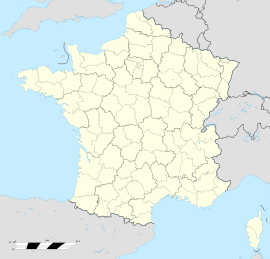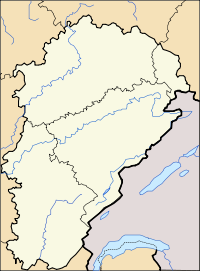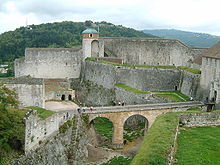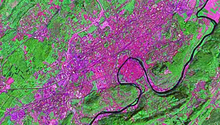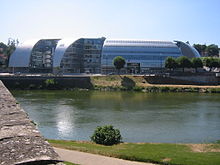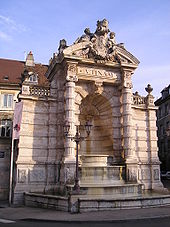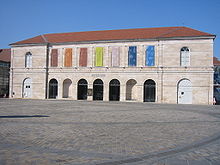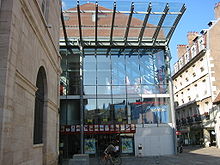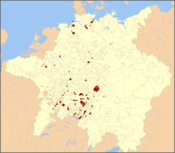- Besançon
-
"Bisanz" redirects here. For the German association football (soccer) coach, see Gero Bisanz.
Besançon
Motto: Pleut A Dieu ("If God wills") or Utinam
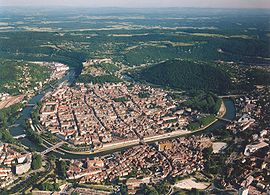
The old city of Besançon
and the meander of the Doubs River.

Administration Country France Region Franche-Comté Department Doubs Intercommunality Grand Besançon Mayor Jean-Louis Fousseret (PS)
(2008–2014)Statistics Land area1 65.05 km2 (25.12 sq mi) Population2 117,599 (2008) - Ranking 29th in France - Density 1,808 /km2 (4,680 /sq mi) Urban area 122 km2 (47 sq mi) (1999) - Population 134,376 (1999) Metro area 1,652 km2 (638 sq mi) (1999) - Population 222,381 (1999) Website http://www.besancon.fr/ 1 French Land Register data, which excludes lakes, ponds, glaciers > 1 km² (0.386 sq mi or 247 acres) and river estuaries. 2 Population without double counting: residents of multiple communes (e.g., students and military personnel) only counted once. Coordinates: 47°14′35″N 6°01′19″E / 47.24306°N 6.02194°E
Besançon (French and Arpitan: [bəzɑ̃ˈsɔ̃]; archaic German: Bisanz, Spanish: Besanzón), is the capital and principal city of the Franche-Comté region in eastern France. It had a population of about 237,000 inhabitants in the metropolitan area in 2008. Located close to the border with Switzerland, it is the capital of the department of Doubs.
Once proclaimed first green city of France, it has been labeled a 'Town of Art and History' since 1986, and has been on the UNESCO world heritage list since 2008.[1]
Contents
History
Toponymy
The city is first recorded in 58 BC as Vesontio in the Book I of Julius Caesar's Commentarii de Bello Gallico. The etymology of Vesontio is uncertain. The most common explanation is that the name is of Celtic origin, derivated from wes, meaning 'mountain'. During the 4th century, the letter B took the place of the V, and the city name changed to Besontio or Bisontion and then underwent several transformation to become Besançon in 1243.
Ancient history
 Map of Vesontio: Besançon's name during the Roman Empire
Map of Vesontio: Besançon's name during the Roman Empire
The city sits within an oxbow of the Doubs River (a tributary of the Rhône River); a mountain closes the fourth side. During the Bronze Age, c.1500 BCE, tribes of Gauls settled the oxbow.
From the 1st century BC through the modern era, the town had a significant military importance because the Alps rise abruptly to its immediate south, presenting a significant natural barrier. In historic times the town was first recorded in the journals of Julius Caesar, in his commentaries detailing his conquest of Gaul, as the largest town of the Sequani, a smaller Gaulic tribe; Caesar gave the name of the town as Vesontio (possibly Latinized), and mentions that a wooden palisade surrounded it.
Over the centuries, the name permutated to become Besantio, Besontion, Bisanz in Middle High German and gradually arrived at the modern French Besançon. The locals retain their ancient heritage referring to themselves as Bisontins (feminine: Bisontine).
It has been an archbishopric since the 4th century.
Middle Ages
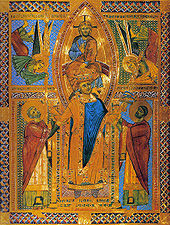 Henry II, Holy Roman Emperor inherited the city and made it part of the Holy Roman Empire in 1032.
Henry II, Holy Roman Emperor inherited the city and made it part of the Holy Roman Empire in 1032.
In 843, the Treaty of Verdun divided up Charlemagne's empire. Besançon became part of Lotharingie, under the Duke of Burgundy.
As part of the Holy Roman Empire since 1034, the city became the Archbishopric of Besançon, and became the Free Imperial City of Besançon (an autonomous city-state under the Holy Roman Emperor) in 1184. In 1157, Emperor Frederick Barbarossa held the Diet of Besançon. There, Cardinal Orlando Bandinelli (the future Pope Alexander III, then adviser of Pope Adrian IV) openly asserted before the Emperor that the Imperial dignity was a Papal beneficium (in the more general sense of favour, not the strict feudal sense of fief), which incurred the wrath of the German princes. He would have fallen on the spot under the battle-axe of his life-long foe, Otto of Wittelsbach, had Frederick not intervened. The Imperial Chancellor Rainald of Dassel then inaugurated a German policy that insisted upon the rights and the power of the German kings, the strengthening of the Church in the German Empire, the lordship of Italy and the humiliation of the Papacy. The Archbishops were elevated to Princes of the Holy Roman Empire in 1288. The close connection to the Empire is reflected in the city's coat of arms.
In 1290, after a century of fighting against the power of the archbishops, the Emperor granted Besançon its independence.
Renaissance
In the 15th century, Besançon came under the influence of the dukes of Burgundy. After the marriage of Mary of Burgundy to Maximilian I, Holy Roman Emperor, the city was in effect a Habsburg fief. In 1519 Charles V, Holy Roman Emperor, King of Spain, became the Holy Roman Emperor. This made him master of Franche-Comté and Besançon, a francophone German city. In 1526 the city obtained the right to mint coins, which it continued to strike until 1673. Nevertheless, all coins bore the name of Charles V.
When Charles V abdicated in 1555, he gave Franche-Comté to his son, Philip II, King of Spain. Besançon remained a free imperial city under the protection of the King of Spain. In 1598, Philip II gave the province to his daughter on her marriage to an Austrian archduke. It remained formally a portion of the Empire until its cession at the peace of Westphalia in 1648. Spain regained control of Franche-Comté and the city lost its status as a free city. Then in 1667, Louis XIV claimed the province as a consequence of his marriage to Marie-Thérèse of Spain.
Louis conquered the city for the first time in 1668, but the Treaty of Aix-la-Chapelle returned it to Spain within a matter of months. While it was in French hands, the famed military engineer Vauban visited the city and drew up plans for its fortification. The Spaniards built the main centre point of the city's defences, "la Citadelle", siting it on Mont St. Etiene, which closes the neck of the bend in the river that encloses the old city. In their construction, they followed Vauban's designs.
In 1674, French troops again took the city, which the Treaty of Nijmegen (1678) then awarded to France. At this time the city became the administrative centre for Franche-Comté, with the Parlement of Besançon, replacing Dole.
As a result of control passing to France, Vauban returned to working on the citadel's fortifications, and those of the city, a process that took some 30 years, until 1711. Walls built in that era surround the city. Between the train station and the central city there is a complex moat system that now serves road traffic. Numerous forts, some of which date back to the time and that incorporate Vauban's designs elements, sit on the six hills that surround the city: Fort de Trois Châtels, Fort Chaudanne, Fort du Petit Chaudanne, Fort Griffon, Fort des Justices, Fort Beauregard and Fort de Brégille. The citadel itself has two dry moats, with an outer and inner court. In the evenings, the Citadelle is illuminated and stands above the city as a landmark and a testament to Vauban's genius as a military engineer.
Modern Europe
In 1814 the Austrians invested and bombarded the city. It also occupied an important position during the Franco-Prussian War of 1870–71.
The Nazis occupied the citadel during World War II. Between 1940 and 1944, the Germans executed some one hundred French resistance fighters there. However, Besançon saw little action during the war. The railway complex was bombed in 1943 and the next year the Germans resisted the U.S. advance for four days. In 1959, the French Army turned the citadel over to the city of Besançon, which turned it into a museum.
The forts of Brégille and Beauregard sit across the Doubs from the town. In 1913, a private company built a funicular to the Brégille Heights. The funicular passed from private ownership to the SNCF, who finally closed it in 1987. The funicular's tracks, stations and even road signs remain in place to this day.
Geography
Location
Besançon is located in the north-east quarter of France on the Doubs River. It is about 325 km (215 mi) east of the national capital of Paris, 100 km (60 mi) east of Dijon in Burgundy, 125 km (75 mi) northwest of Lausanne in Switzerland, and 100 km (60 mi) southwest of Belfort in Franche-Comté. It is located at the edge of the Jura Mountains.
Topography
The city initially developed in a natural meander (or oxbow loop) of the Doubs River with a diameter of almost 1 km (3,281 ft). The flat inner loop has an elevation of about 250 m (820 ft) and is bounded to the south by a hill called Mont Saint-Étienne, which has a maximum height of 371 m (1,217 ft). The city is surrounded by six other hills which range in elevation from 400 m (1,312 ft) to 500 m (1,640 ft): Brégille, Griffon, Planoise, Chaudanne, Montfaucon, and Montboucon. (There is a barge canal that cuts through rock under Mont Saint-Étienne, short-cutting the meander.)
Climate
Besançon is under the influence of both an oceanic climate (notable precipitations in quantity as much as in frequency) and a continental climate with hard winters (snow, frost) and warm and dry summers. The year-round average is 11.5 °C (53 °F). The warmest month is July 20 °C (68 °F) and the coldest is January 2.1 °C (36 °F). Besançon receives about 1059 mm (41.7 inches) of precipitation per year. The wettest month is May (108.4 mm or 4.3 in); the driest is August (76.9 mm or 3 in). The highest temperature ever, recorded on 28 July 1921, was 40.3 °C (105 °F), and the lowest was a −20.7 °C (−5 °F) reached on 1 January 1985.
Climate data for Besançon Month Jan Feb Mar Apr May Jun Jul Aug Sep Oct Nov Dec Year Average high °C (°F) 5
(41)6.1
(43.0)10.8
(51.4)14.9
(58.8)20.7
(69.3)23.4
(74.1)25.7
(78.3)26.1
(79.0)22.2
(72.0)18.0
(64.4)13.2
(55.8)7.1
(44.8)16.1 Daily mean °C (°F) 2.1
(35.8)3.1
(37.6)6.7
(44.1)9.7
(49.5)15.2
(59.4)17.9
(64.2)20
(68)20.2
(68.4)16.9
(62.4)13.4
(56.1)8.8
(47.8)4.1
(39.4)11.5 Average low °C (°F) −0.8
(30.6)0
(32)2.5
(36.5)4.5
(40.1)9.7
(49.5)12.4
(54.3)14.2
(57.6)14.3
(57.7)11.6
(52.9)8.8
(47.8)4.4
(39.9)1.0
(33.8)6.9 Rainfall mm (inches) 88.5
(3.484)81.8
(3.22)83.5
(3.287)90.6
(3.567)108.4
(4.268)97.1
(3.823)78.5
(3.091)76.9
(3.028)78.2
(3.079)85.8
(3.378)96.7
(3.807)93.0
(3.661)1,059
(41.69)Source: Météo France Districts
Main article: PlanoiseThe 14 Besançon boroughs 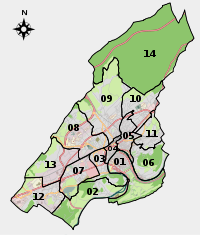
- Montboucons – Montrapon
- Saint-Claude – Torcols
- Palente – Orchamps – Saragosse
- Vaites – Clairs-Soleils
- Planoise – Châteaufarine
- Tilleroyes
- Chailluz
- Center (the buckleet and Saint-Jean) – Chapelle des Buis
- Battant
- Bregille
- Vaites – Clairs-Soleils
- Velotte
- Butte – Grette
- Chaprais – Cras
- Palente – Orchamps – Combe Saragosse
- Tilleroyes
- Montrapon – Montboucons – Fontaine-écu
- Planoise – Châteaufarine
- Saint-Claude – Torcols
- Saint-Ferjeux – Rosemont
- Chailluz
Parks and gardens
- Jardin botanique de Besançon
- Parc Micaud
- Parc de la Gare d'Eau
- Parc de la Citadelle
- Promenade Granvelle
- Promenade Chamars
Demography
As of the French Census of 2008, the population of the City of Besançon was 117,599, lower than the historical peak of 120,315 in 1975. Grand Besançon covers 122 km2 (47 sq mi), 11 municipalities and has a population of 135,652. The metropolitan area covers 1,652 km2 (638 sq mi), 234 municipalities and has 236,968 inhabitants. It is the thirty-seventh of France. It increased by 6.6% between 1999 and 2008.
Historical populations Year Pop. ±% 1800 28,436 — 1836 29,718 +4.5% 1841 36,461 +22.7% 1861 46,786 +28.3% 1876 54,404 +16.3% 1896 57,556 +5.8% 1911 57,978 +0.7% 1921 55,652 −4.0% 1936 65,022 +16.8% 1946 63,508 −2.3% 1954 73,445 +15.6% 1962 95,642 +30.2% 1968 113,220 +18.4% 1975 120,315 +6.3% 1982 113,283 −5.8% 1990 113,828 +0.5% 1999 117,733 +3.4% 2008 117,599 −0.1% Government and politics
Besançon is the capital of the Franche-Comté région of France, a région including the four départements of Doubs, Haute-Saône, Jura and Territoire de Belfort. As such, it is the seat of the Franche-Comté regional council, and the regional préfecture (government offices).
Mayor of the City of Besançon is Jean-Louis Fousseret.
Economy
The city is famous for its microtechnology and watch industries. It is host of the biannual Micronora trade fair, one of Europe's major events in the field of microtechnologies. The city has a little-known specialty, automatic ticketing machines for car parking, airports, date stamping etc.
The watch industry, for which Besançon remains the French capital, endured a major crisis in the 1970s when the advent of quartz watches from Asia knocked out the traditional watch industry in the space of just a few years. The famous "Lip" affair epitomizes the industrial crisis. LIP is to this day the name of one of Besançon's most prestigious brands of watches. Refusing to let their factory close, the workers set up a cooperative to run it. The action produced a lot of notoriety and sympathy for the workers but also resulted in branding Besançon as a city of the radical left. It also did nothing to help revive the watch industry; the cooperative went out of business a short while later. The city took a long time to recover from the collapse of the watch industry and its other major industry of the industrial age, artificial textiles.
Since the 1980s, Besançon's watch industry has clawed its way back on the basis of its historic reputation and quartz watches, establishing itself in a number of niche markets including customized watches, high quality watches, and fashion articles. Since the 1990s, the town has developed a reputation as one of France's leading centres of technology in all fields, including telecommunications and biotechnology.
Education
Besançon is the seat of the Université de Franche-Comté. As of 2006, there were approximately 20,000 students enrolled at the university, including around 3,000 foreign students. The Institut Supérieur d'Ingénieurs de Franche-Comté[2] (ISIFC), part of the Université de Franche-Comté, is the first school created in the country specifically for the Biomedical engineering field. The city is also home of the École Nationale Supérieure de Mécanique et des Microtechniques (ENSMM), a technological school with a strong reputation in the fields of microtechnology and mechanics and the worldwide famous Centre for Applied Linguistics which teaches ten languages to non-native speakers (French, Arabic, Chinese, English, German, Italian, Japanese, Portuguese, Russian, Spanish) and any other known language on request and which welcomes more than 3,000 students every year from all over the world.
Culture
Sites of interest
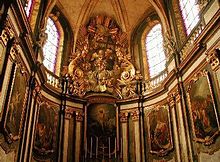 Interior of St. Jean Cathedral in Besançon
Interior of St. Jean Cathedral in Besançon
 General view of Vauban's Citadel.
General view of Vauban's Citadel.
The city has one of the most beautiful historic centers of any major town in France. A broad horse-shoe of the river Doubs, "la Boucle", encircles the old town, while Vauban's imposing Citadelle blocks off the neck. The historic center presents a remarkable ensemble of classic stone buildings, some dating back to the Middle Ages and others to the Spanish Renaissance. Among the most visited historic monuments are:
- several Roman remains,
- the 16th century Palais Granvelle,
- Vauban's citadel (Citadel of Besançon)
- the Cathedral of St. Jean,
- several Spanish Renaissance-style buildings
- the Église de la Madeleine, and
- the river frontage.
The Roman remains consist primarily of the Porte Noire, a 2nd century CE triumphal arch at the foot of the hill on which the citadel stands, and the Square Castan, a semi-circular amphitheater. The Porte Noire may commemorate the victories of Marcus Aurelius over the Germans in 167 CE. It was partly rebuilt in 1820.
From 1534 to 1540, Cardinal Granvelle, chancellor to the Habsburg emperor Charles V, built the Palais Granvelle, in the heart of the town.[3][4] It consists of arcades that surround an interior court, and is the most interesting of the secular buildings. The Palais contains a set of seven wool and silk blend tapestries from Bruges that were woven circa 1635 and that celebrate seven milestones in Charles V's life. These tapestries remained in Spain until 1888, when they were transferred to France. In 1950 they were transferred to the Palais.
UNESCO added the citadel, the city walls and Fort Griffon to its list of World Heritage Sites in 2008, as part of the "Fortifications of Vauban" group. Some older military architecture has also survived. There is a cylindrical, 15th century tower near the Porte Notre-Dame, the southern gate of the city. The Porte Rivotte, a 16th century gate, has two round towers. The citadel houses the Museum of the French Resistance and Deportation.
The Cathedral, which dates largely from the 12th century[5] though construction continued into the 14th century, contains the most remarkable of the city's masterpieces, a massive Virgin and saints altarpiece by the Italian Renaissance painter Fra Bartolomeo. It also houses a noteworthy 19th century astronomical clock. The Cathedral has two apses, with the eastern apse and the tower dating from the reign of Louis XV.
Attractive quays border the old city, and in places there are shady promenades. On the right bank there is a bathing establishment in the Mouillere quarter that draws its water from the saline springs of Miserey-Salines.
Besançon also has one of the finest city art galleries in France outside Paris. The Museum of Fine Arts and Archeology has a collection whose origins date to 1694, and which a remarkable series of bequests have augmented over time. In the 1960s the architect Luis Miquel, a pupil of Le Corbusier, totally rebuilt the building. The building's interior takes the form of a gently rising concrete walkway that takes visitors up from classical antiquity to the modern age. Among the museum's treasures are a fine collection of classical antiquities and ancient Egyptian artifacts, as well as a very rich collection of paintings including works by Bellini, Bronzino, Tintoretto, Titian, Rubens, Jordaens, Ruysdael, Cranach, Zurbarán, Goya, Philippe de Champaigne, Fragonard, Boucher, David, Ingres, Géricault, Courbet, Constable, Bonnard, Matisse, Picasso and many others.
As well as being famed as one of France's finest "villes d'art" (art cities), Besançon is the seat of one of France's older universities, of France's National School of Mechanics and Micromechanics, and one of the best known French language schools in France, the CLA. It is also reputed[citation needed] to be France's most environmentally-friendly city, with a public transport network that has often been cited as a model. On account of the topography, the historic city centre lies at the edge of the modern city, and hiking tracks lead straight from the centre and up into the surrounding hills. The city council has been in the hands of the Socialists and parties of the left since the Second World War. Queen Beatrix of the Netherlands is also the Lady of Besançon.
The Christmas carol "Berger, Secoue Ton Sommeil Profond", known in English as "Shepherds, Shake Off Your Drowsy Sleep" originated in Besançon in the 17th century.
Other museums, aquariums, and zoos
- Museum of Time
- Museum of Franche-Comté
- Museum of Natural history, which contains a zoo, aquarium, insectarium, noctarium, and a climatology exhibit
Performing arts centers
- Opéra Théâtre: construit par Ledoux de 1778 à 1784
- Grand Kursaal
- Nouveau Théâtre – Centre Dramatique National
- Cirque Plume
- Théâtre Bacchus
- Théâtre de la Bouloie
- Théâtre de l'Espace
Annual cultural events and fairs
Several major events occur annually in Besançon. One of the best-known is the Besançon International Music Festival, which takes place in September; it is one of the oldest and most prestigious Classical music festivals. Besançon hosts other music festivals such as the Herbe en Zik Festival (French rock and variety) in May, the Jazz en Franche-Comté Festival in June, the Franch Country Festival (country music) in August, and the Musiques de Rues Festival (street music) in October.
Sports
The major sports in Besançon are handball and basketball. The city's soccer club, called Besançon Racing Club plays in the French fourth division.
Besançon also had a fairly successful hockey team in the early 21st century. The Séquanes, named after an ancient gallic tribe, reached the French Cup final in 2002 (which the city hosted) and briefly played in the country's top league, then called Super 16.
However the Séquanes' free spending policy soon backfired. The team folded in the middle of the 2002/03 season due to financial problems. Today, senior hockey subsists in Besançon in the form of a low level amateur team. The town also had a good Canoe-Kayak Club, Sport Nautique Bisontin, one of the oldest in France.Club Sport League Stadium Besançon Racing Club Football Championnat de France Amateurs Stade Léo Lagrange Entente Sportive Bisontine Masculin Handball Nationale 1 Gymnase des Montboucons Entente Sportive Bisontine Feminin Handball Division 1 (women's) Palais des Sports Transport
Besançon is situated at the crossing of two major lines of communication, the NE-SW route, following the valley of the river Doubs, and linking Germany and North Europe with Lyon and southwest Europe, and the N-S route linking northern France and the Netherlands with Switzerland. A key staging post on the Strasbourg-Lyon (Germany-Spain) route, it also has direct high-speed train (TGV) links with Paris, Charles de Gaulle Airport, and Lille from its Gare de Besançon-Viotte. Unusually for a town of its size, it does not have a commercial airport, though two international airports, EuroAirport Basel-Mulhouse-Freiburg and Lyon Saint-Exupéry International Airport, can be reached in about 2 hours. Ginko is the bus company which runs the urban transport of Besançon
Births
 The birthplace of Victor Hugo in Besançon
The birthplace of Victor Hugo in Besançon
Besançon was the birthplace of:
- Claude Goudimel (1510–1572) – Musician, Teacher of Palestrina. Composer of the music for Protestant hymns
- Antoine Perrenot de Granvelle (1517–1586) – Cardinal, statesman and humanist. Counsellor of Charles V, Viceroy of Naples
- Jean Mairet (1604–1686) – Dramatist
- Charles Fourier (1772–1837) – Inventor of socialist "phalansteries" (vast communal buildings surrounded by a highly cultivated agricultural area)
- Charles Nodier (1780–1844) – Writer. Leader of the Romantic movement
- Jean Claude Eugène Péclet (1793–1857) – physicist, gave his name to the Péclet number
- Victor Hugo (1802–1885) – Writer and poet
- Pierre-Joseph Proudhon (1809–1865)- Journalist (Le Peuple) and author of world-renowned anarchist theories
- Hilaire de Chardonnet (1838–1924) – Inventor of artificial silk
- Louis-Jean Résal (1854–1920) – Engineer who built the Pont Mirabeau and the Pont Alexandre III in Paris
- Auguste and Louis Lumière, (1862–1954) and (1864–1948) – Inventors of cinematography
- Tristan Bernard (1866–1947) – Journalist and Humorist
- Albert Seitz (1872–1937) – composer and violist
- Ludovic Arrachart (1897–1933), aviator
- Jean de Gribaldy (1922–1987) – Professional racing cyclist and directeur sportif
- Raymond Blanc (1949– ) – Chef
- Morrade Hakkar (1972– ) – Boxer
- Gaspard Augé (1979– ) – One half of electro group Justice
- Cyril Kali footballer
- Yohann Lasimant footballer
- Lucien Laurent footballer
Popular culture
- Julius Caesar, in his account Commentarii de Bello Gallico gives a description of the antique city of Besançon, named Vesontio (first book, section 38):
-
- [1.38] When he had proceeded three days' journey, word was brought to him that Ariovistus was hastening with all his forces to seize on Vesontio, which is the largest town of the Sequani, and had advanced three days' journey from its territories. Caesar thought that he ought to take the greatest precautions lest this should happen, for there was in that town a most ample supply of every thing which was serviceable for war; and so fortified was it by the nature of the ground, as to afford a great facility for protracting the war, inasmuch as the river Doubs almost surrounds the whole town, as though it were traced round it with a pair of compasses. A mountain of great height shuts in the remaining space, which is not more than 600 feet (180 m), where the river leaves a gap, in such a manner that the roots of that mountain extend to the river's bank on either side. A wall thrown around it makes a citadel of this [mountain], and connects it with the town.
- Gary Jennings's novel "Raptor", which takes place in the 5th century AD, describes Vesontio lavishly.
- In Stendhal's novel Le rouge et le noir, Julien Sorel, the main character, studies for a while at the Catholic seminary at Besançon (first book, chapters 24 to 30):
-
- Eventually he saw the white walls beyond the distant mountain; it was the citadel of Besançon. "What a difference", he said, sighing, "if I could come into this fine city as a sub-lieutenant of one of these regiments of the post." Besançon is not only one of the prettiest cities in France, but it abounds in brave and intelligent men. Julien, however, was only a little peasant, without any means of approaching distinguished personages.
- In the poem This century was two years old (Les Feuilles d'automne; literally – "The Leaves of Autumn"), Victor Hugo evokes his birth in Besançon:
-
- This century was two years old. Rome was replacing Sparta;
- Already Napoleon was emerging from under Bonaparte.
- And already the First Consul's tight mask
- Had been split in several places by the Emperor's brow.
- It was then that in Besançon, that old Spanish town,
- Cast like a seed into the flying wind,
- A child was born of mixed blood—Breton and Lorraine --
- Pallid, blind and mute,...
- That child, whom Life was scratching from its book,
- And who had not another day to live,
- Was me.
- Besançon is where the Touché! series, an Australian series of books that teaches people French, is set. The series is about an Australian boy called Nick, who moves to Besançon after his parents separate. He settles in a street called rue Cézanne where he befriends a French girl called Marianne. She introduces him to other residents of rue Cézanne, such as Ahmed, Annick, François Petitpain, Émile Mesquin, Monsieur Fric, Madame Boulin and Mademoiselle Moh. The first two books of the series take place in Besançon, whilst in the third, Nick visits his uncle in New Caledonia. In the fourth, Nick stays in Quebec, Canada. After the fourth book, Nick returns to Besançon.
- Julian Barnes' novel A History of the World in 10½ Chapters features as chapter 3: "Wars of Religion"--a fictional manuscript reportedly from the Archives Municipales de Besançon.
Balzac's novel Albert Savaron takes place in Besançon.
Colonel Sainte-Hermine, the fictional hero of Alexandre Dumas' The Last Cavalier, is a native of Besançon.
Twin cities
 Tver (Russia)
Tver (Russia) Freiburg im Breisgau (Germany)
Freiburg im Breisgau (Germany) Kuopio (Finland)
Kuopio (Finland) Huddersfield – Kirklees (United Kingdom)
Huddersfield – Kirklees (United Kingdom) Bielsko-Biala (Poland)
Bielsko-Biala (Poland) Neuchâtel (Switzerland)
Neuchâtel (Switzerland) Bistriţa (Romania)
Bistriţa (Romania) Pavia (Italy)
Pavia (Italy) Hadera (Israel)
Hadera (Israel) Douroula (Burkina Faso)
Douroula (Burkina Faso) Man (Côte d'Ivoire)
Man (Côte d'Ivoire) Charlottesville – Virginia (United States)
Charlottesville – Virginia (United States)
See also
References
- ^ Considering surface green spaces per inhabitant, Numbers available on the encyclopedia site Quid, at the bottom of the page
- ^ "Institut Supérieur d'Ingénieurs de Franche-Comté (Besançon) web site". http://isifc.univ-fcomte.fr/. Retrieved 20 June 2011.
- ^ http://www.kunsttrip.nl/images/besancon/facade%20van%20het%20palais%20granvelle%20becancon.jpg
- ^ http://familledoderen.canalblog.com/images/besancon_palais.jpg
- ^ http://www.coulouris.net/george-jean/tandemfrance2003/besancon/Images/9.jpg
External links
- City Council Website (in French)
- Besançon – All Events in Besançon, Real City Guide (in French)
- Besac.com: Online Média for Besançon: Events, Classifieds, Online Shops (in French)
- Unofficial Funicular Website (bilingual, French/English)
- Official Funicular Website (French only)
- Webpage about the Fortifications
- Besançon Hymn
- Besançon and around area directory search engine (in French)
 Burgundian Circle (1512–1806) of the Holy Roman EmpireRemained
Burgundian Circle (1512–1806) of the Holy Roman EmpireRemained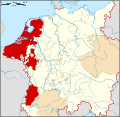
County Imperial City Besançon3Dependent territories Prefectures of Departments of France Bourg-en-Bresse (Ain) · Laon (Aisne) · Moulins (Allier) · Digne-les-Bains (Alpes-de-Haute-Provence) · Gap (Hautes-Alpes) · Nice (Alpes-Maritimes) · Privas (Ardèche) · Charleville-Mézières (Ardennes) · Foix (Ariège) · Troyes (Aube) · Carcassonne (Aude) · Rodez (Aveyron) · Marseille (Bouches-du-Rhône) · Caen (Calvados) · Aurillac (Cantal) · Angoulême (Charente) · La Rochelle (Charente-Maritime) · Bourges (Cher) · Tulle (Corrèze) · Ajaccio (Corse-du-Sud) · Bastia (Haute-Corse) · Dijon (Côte-d'Or) · Saint-Brieuc (Côtes-d'Armor) · Guéret (Creuse) · Périgueux (Dordogne) · Besançon (Doubs) · Valence (Drôme) · Évreux (Eure) · Chartres (Eure-et-Loir) · Quimper (Finistère) · Nîmes (Gard) · Toulouse (Haute-Garonne) · Auch (Gers) · Bordeaux (Gironde) · Montpellier (Hérault) · Rennes (Ille-et-Vilaine) · Châteauroux (Indre) · Tours (Indre-et-Loire) · Grenoble (Isère) · Lons-le-Saunier (Jura) · Mont-de-Marsan (Landes) · Blois (Loir-et-Cher) · Saint-Étienne (Loire) · Le Puy-en-Velay (Haute-Loire) · Nantes (Loire-Atlantique) · Orléans (Loiret) · Cahors (Lot) · Agen (Lot-et-Garonne) · Mende (Lozère) · Angers (Maine-et-Loire) · Saint-Lô (Manche) · Châlons-en-Champagne (Marne) · Chaumont (Haute-Marne) · Laval (Mayenne) · Nancy (Meurthe-et-Moselle) · Bar-le-Duc (Meuse) · Vannes (Morbihan) · Metz (Moselle) · Nevers (Nièvre) · Lille (Nord) · Beauvais (Oise) · Alençon (Orne) · Arras (Pas-de-Calais) · Clermont-Ferrand (Puy-de-Dôme) · Pau (Pyrénées-Atlantiques) · Tarbes (Hautes-Pyrénées) · Perpignan (Pyrénées-Orientales) · Strasbourg (Bas-Rhin) · Colmar (Haut-Rhin) · Lyon (Rhône) · Vesoul (Haute-Saône) · Mâcon (Saône-et-Loire) · Le Mans (Sarthe) · Chambéry (Savoie) · Annecy (Haute-Savoie) · Paris (Paris) · Rouen (Seine-Maritime) · Melun (Seine-et-Marne) · Versailles (Yvelines) · Niort (Deux-Sèvres) · Amiens (Somme) · Albi (Tarn) · Montauban (Tarn-et-Garonne) · Toulon (Var) · Avignon (Vaucluse) · La Roche-sur-Yon (Vendée) · Poitiers (Vienne) · Limoges (Haute-Vienne) · Épinal (Vosges) · Auxerre (Yonne) · Belfort (Territoire de Belfort) · Évry (Essonne) · Nanterre (Hauts-de-Seine) · Bobigny (Seine-Saint-Denis) · Créteil (Val-de-Marne) · Cergy, Pontoise (Val-d'Oise)
Basse-Terre (Guadeloupe) · Fort-de-France (Martinique) · Cayenne (French Guiana) · Saint-Denis (Réunion) · Mamoudzou (Mayotte)
Prefectures of the regions of France Metropolitan France Strasbourg (Alsace) · Bordeaux (Aquitaine) · Clermont-Ferrand (Auvergne) · Dijon (Burgundy) · Rennes (Brittany) · Orléans (Centre) · Châlons-en-Champagne (Champagne-Ardenne) · Ajaccio (Corsica) · Besançon (Franche-Comté) · Paris (Île-de-France) · Montpellier (Languedoc-Roussillon) · Limoges (Limousin) · Metz (Lorraine) · Toulouse (Midi-Pyrénées) · Lille (Nord-Pas de Calais) · Caen (Lower Normandy) · Rouen (Upper Normandy) · Nantes (Pays de la Loire) · Amiens (Picardy) · Poitiers (Poitou-Charentes) · Marseille (Provence-Alpes-Côte d'Azur) · Lyon (Rhône-Alpes)
Overseas regions Cayenne (French Guiana) · Basse-Terre (Guadeloupe) · Fort-de-France (Martinique) · Mamoudzou (Mayotte) · Saint-Denis (Réunion)
Communes of the Doubs department 
Abbans-Dessous · Abbans-Dessus · Abbenans · Abbévillers · Accolans · Adam-lès-Passavant · Adam-lès-Vercel · Aibre · Aïssey · Allenjoie · Les Alliés · Allondans · Amagney · Amancey · Amathay-Vésigneux · Amondans · Anteuil · Appenans · Arbouans · Arc-et-Senans · Arcey · Arçon · Arc-sous-Cicon · Arc-sous-Montenot · Arguel · Athose · Aubonne · Audeux · Audincourt · Autechaux · Autechaux-Roide · Auxon-Dessous · Auxon-Dessus · Avanne-Aveney · Avilley · Avoudrey · Badevel · Bannans · Le Barboux · Bart · Bartherans · Battenans-les-Mines · Battenans-Varin · Baume-les-Dames · Bavans · Belfays · Le Bélieu · Belleherbe · Belmont · Belvoir · Berche · Berthelange · Besançon · Bethoncourt · Beure · Beutal · Bians-les-Usiers · Bief · Le Bizot · Blamont · Blarians · Blussangeaux · Blussans · Bolandoz · Bondeval · Bonnal · Bonnay · Bonnétage · Bonnevaux · Bonnevaux-le-Prieuré · La Bosse · Bouclans · Boujailles · Bourguignon · Bournois · Boussières · Bouverans · Braillans · Branne · Breconchaux · Bremondans · Brères · Les Bréseux · La Bretenière · Bretigney · Bretigney-Notre-Dame · Bretonvillers · Brey-et-Maison-du-Bois · Brognard · Buffard · Bugny · Bulle · Burgille · Burnevillers · Busy · By · Byans-sur-Doubs · Cademène · Cendrey · Cernay-l'Église · Cessey · Chaffois · Chalèze · Chalezeule · Chamesey · Chamesol · Champagney · Champlive · Champoux · Champvans-les-Moulins · Chantrans · Chapelle-des-Bois · Chapelle-d'Huin · Charbonnières-les-Sapins · Charmauvillers · Charmoille · Charnay · Charquemont · Chasnans · Chassagne-Saint-Denis · Châteauvieux-les-Fossés · Châtelblanc · Châtillon-Guyotte · Châtillon-le-Duc · Châtillon-sur-Lison · Chaucenne · Chaudefontaine · La Chaux · Chaux-lès-Clerval · Chaux-lès-Passavant · Chaux-Neuve · Chay · Chazot · Chemaudin · La Chenalotte · Chenecey-Buillon · Chevigney-lès-Vercel · Chevigney-sur-l'Ognon · La Chevillotte · Chevroz · Chouzelot · Cléron · Clerval · La Cluse-et-Mijoux · Colombier-Fontaine · Les Combes · Consolation-Maisonnettes · Corcelle-Mieslot · Corcelles-Ferrières · Corcondray · Côtebrune · Courcelles · Courcelles-lès-Montbéliard · Courchapon · Cour-Saint-Maurice · Courtefontaine · Courtetain-et-Salans · Courvières · Crosey-le-Grand · Crosey-le-Petit · Le Crouzet · Crouzet-Migette · Cubrial · Cubry · Cusance · Cuse-et-Adrisans · Cussey-sur-Lison · Cussey-sur-l'Ognon · Dambelin · Dambenois · Dammartin-les-Templiers · Dampierre-les-Bois · Dampierre-sur-le-Doubs · Dampjoux · Damprichard · Dannemarie · Dannemarie-sur-Crète · Dasle · Deluz · Désandans · Déservillers · Devecey · Dommartin · Dompierre-les-Tilleuls · Domprel · Doubs · Dung · Durnes · Échay · Échenans · Échevannes · École-Valentin · Les Écorces · Écot · L'Écouvotte · Écurcey · Émagny · Épenouse · Épenoy · Épeugney · Esnans · Étalans · Éternoz · Étouvans · Étrabonne · Étrappe · Étray · Étupes · Évillers · Exincourt · Eysson · Faimbe · Fallerans · Ferrières-le-Lac · Ferrières-les-Bois · Fertans · Fesches-le-Châtel · Fessevillers · Feule · Les Fins · Flagey · Flagey-Rigney · Flangebouche · Fleurey · Fontain · Fontaine-lès-Clerval · Fontenelle-Montby · Les Fontenelles · Fontenotte · Foucherans · Fourbanne · Fourcatier-et-Maison-Neuve · Fourg · Les Fourgs · Fournet-Blancheroche · Fournets-Luisans · Frambouhans · Franey · Franois · Frasne · Froidevaux · Fuans · Gellin · Gémonval · Geneuille · Geney · Gennes · Germéfontaine · Germondans · Gevresin · Gilley · Glamondans · Glay · Glère · Gondenans-les-Moulins · Gondenans-Montby · Gonsans · Gouhelans · Goumois · Goux-lès-Dambelin · Goux-les-Usiers · Goux-sous-Landet · Grand-Charmont · Grand'Combe-Châteleu · Grand'Combe-des-Bois · Grandfontaine · Grandfontaine-sur-Creuse · La Grange · Granges-Narboz · Les Grangettes · Les Gras · Le Gratteris · Grosbois · Guillon-les-Bains · Guyans-Durnes · Guyans-Vennes · Hautepierre-le-Châtelet · Hauterive-la-Fresse · Hérimoncourt · L'Hôpital-du-Grosbois · L'Hôpital-Saint-Lieffroy · Les Hôpitaux-Neufs · Les Hôpitaux-Vieux · Houtaud · Huanne-Montmartin · Hyémondans · Hyèvre-Magny · Hyèvre-Paroisse · Indevillers · L'Isle-sur-le-Doubs · Issans · Jallerange · Jougne · Labergement-du-Navois · Labergement-Sainte-Marie · Laire · Laissey · Lanans · Landresse · Lantenne-Vertière · Lanthenans · Larnod · Laval-le-Prieuré · Lavans-Quingey · Lavans-Vuillafans · Lavernay · Laviron · Levier · Liebvillers · Liesle · Lizine · Lods · Lombard · Lomont-sur-Crête · Longechaux · Longemaison · Longevelle-lès-Russey · Longevelle-sur-Doubs · Longeville · La Longeville · Longevilles-Mont-d'Or · Loray · Lougres · Le Luhier · Luxiol · Magny-Châtelard · Maîche · Maisons-du-Bois-Lièvremont · Malans · Malbrans · Malbuisson · Malpas · Mamirolle · Mancenans · Mancenans-Lizerne · Mandeure · Marchaux · Marvelise · Mathay · Mazerolles-le-Salin · Médière · Le Mémont · Mercey-le-Grand · Mérey-sous-Montrond · Mérey-Vieilley · Mésandans · Meslières · Mesmay · Métabief · Miserey-Salines · Moncey · Moncley · Mondon · Montagney-Servigney · Montancy · Montandon · Montbéliard · Montbéliardot · Montbenoît · Mont-de-Laval · Mont-de-Vougney · Montécheroux · Montenois · Montfaucon · Montferrand-le-Château · Montflovin · Montfort · Montgesoye · Montivernage · Montjoie-le-Château · Montlebon · Montmahoux · Montperreux · Montrond-le-Château · Montussaint · Morre · Morteau · Mouthe · Le Moutherot · Mouthier-Haute-Pierre · Myon · Naisey-les-Granges · Nancray · Nans · Nans-sous-Sainte-Anne · Narbief · Neuchâtel-Urtière · Nods · Noël-Cerneux · Noirefontaine · Noironte · Nommay · Novillars · Ollans · Onans · Orchamps-Vennes · Orgeans-Blanchefontaine · Ornans · Orsans · Orve · Osse · Osselle · Ougney-Douvot · Ouhans · Ouvans · Oye-et-Pallet · Palantine · Palise · Paroy · Passavant · Passonfontaine · Pelousey · Péseux · Pessans · Petite-Chaux · Pierrefontaine-lès-Blamont · Pierrefontaine-les-Varans · Pirey · Placey · Plaimbois-du-Miroir · Plaimbois-Vennes · Les Plains-et-Grands-Essarts · La Planée · Pointvillers · Pompierre-sur-Doubs · Pontarlier · Pont-de-Roide · Les Pontets · Pont-les-Moulins · Pouilley-Français · Pouilley-les-Vignes · Pouligney-Lusans · Présentevillers · La Prétière · Provenchère · Puessans · Pugey · Le Puy · Quingey · Rahon · Rancenay · Randevillers · Rang · Rantechaux · Raynans · Recologne · Reculfoz · Rémondans-Vaivre · Remoray-Boujeons · Renédale · Rennes-sur-Loue · Reugney · Rigney · Rignosot · Rillans · La Rivière-Drugeon · Rochejean · Roche-lès-Clerval · Roche-lez-Beaupré · Roches-lès-Blamont · Rognon · Romain · Ronchaux · Rondefontaine · Roset-Fluans · Rosières-sur-Barbèche · Rosureux · Rougemont · Rougemontot · Rouhe · Roulans · Routelle · Ruffey-le-Château · Rurey · Le Russey · Saint-Antoine · Sainte-Anne · Sainte-Colombe · Sainte-Marie · Sainte-Suzanne · Saint-Georges-Armont · Saint-Gorgon-Main · Saint-Hilaire · Saint-Hippolyte · Saint-Juan · Saint-Julien-lès-Montbéliard · Saint-Julien-lès-Russey · Saint-Maurice-Colombier · Saint-Point-Lac · Saint-Vit · Samson · Sancey-le-Grand · Sancey-le-Long · Santoche · Saône · Saraz · Sarrageois · Saules · Sauvagney · Scey-Maisières · Séchin · Seloncourt · Semondans · Septfontaines · Serre-les-Sapins · Servin · Silley-Amancey · Silley-Bléfond · Sochaux · Solemont · Sombacour · La Sommette · Soulce-Cernay · Sourans · Soye · Surmont · Taillecourt · Tallans · Tallenay · Tarcenay · Les Terres-de-Chaux · Thiébouhans · Thise · Thoraise · Thulay · Thurey-le-Mont · Torpes · Touillon-et-Loutelet · La Tour-de-Sçay · Tournans · Trépot · Tressandans · Trévillers · Trouvans · Urtière · Uzelle · Vaire-Arcier · Vaire-le-Petit · Valdahon · Val-de-Roulans · Valentigney · Valleroy · Valonne · Valoreille · Vanclans · Vandoncourt · Vauchamps · Vaucluse · Vauclusotte · Vaudrivillers · Vaufrey · Vaux-et-Chantegrue · Vaux-les-Prés · Velesmes-Essarts · Vellerot-lès-Belvoir · Vellerot-lès-Vercel · Vellevans · Venise · Vennans · Vennes · Vercel-Villedieu-le-Camp · Vergranne · Verne · Vernierfontaine · Vernois-lès-Belvoir · Le Vernoy · Verrières-de-Joux · Verrières-du-Grosbois · La Vèze · Vieilley · Viéthorey · Vieux-Charmont · Villars-lès-Blamont · Villars-Saint-Georges · Villars-sous-Dampjoux · Villars-sous-Écot · Les Villedieu · Ville-du-Pont · Villeneuve-d'Amont · Villers-Buzon · Villers-Chief · Villers-Grélot · Villers-la-Combe · Villers-le-Lac · Villers-Saint-Martin · Villers-sous-Chalamont · Villers-sous-Montrond · Voillans · Voires · Vorges-les-Pins · Voujeaucourt · Vuillafans · Vuillecin · Vyt-lès-Belvoir
Wikimedia Foundation. 2010.

